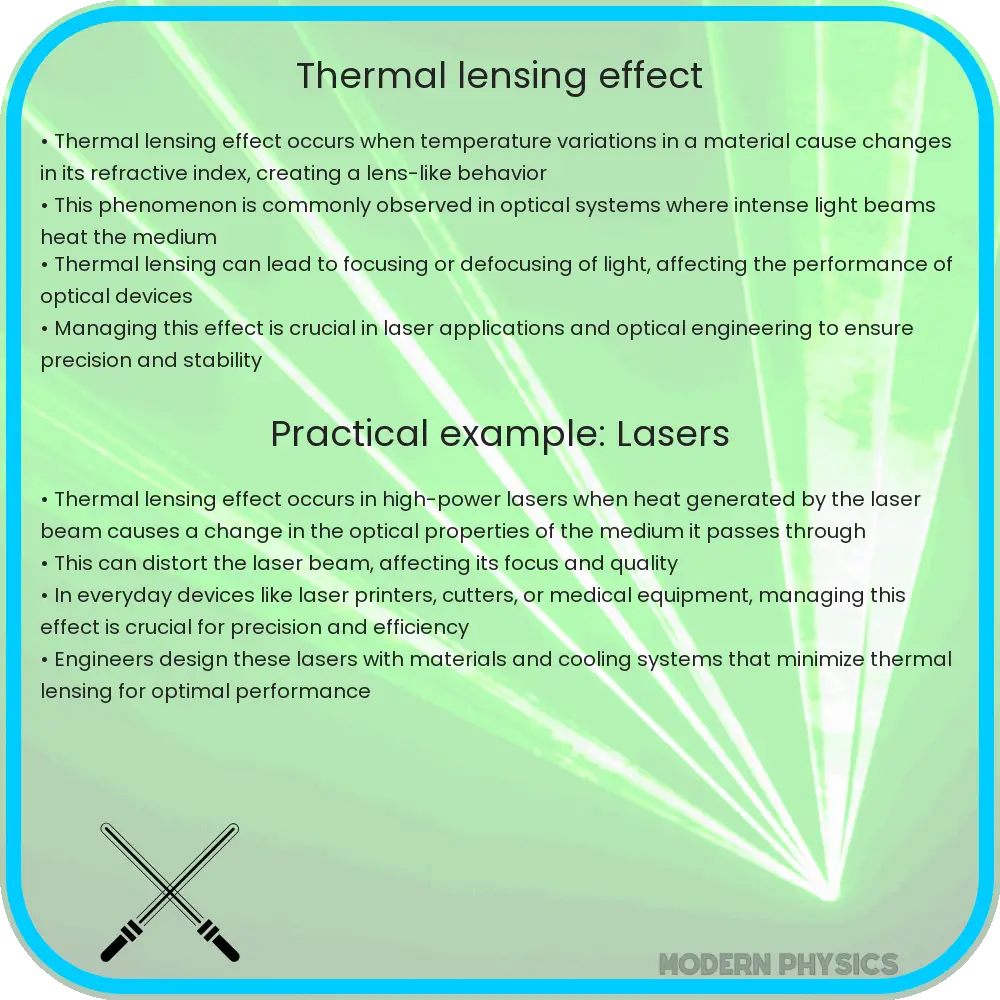Explore the causes, impacts, and control of thermal lensing in optics, a key factor in laser technology, astronomy, and material processing.

Understanding Thermal Lensing Effect: Causes and Impacts
Thermal lensing, a phenomenon prevalent in various scientific and industrial applications, arises when a temperature gradient leads to a non-uniform refractive index in a medium. This results in lens-like behavior, affecting light propagation through the medium. In this article, we delve into the causes, impacts, and control measures of thermal lensing.
Causes of Thermal Lensing
The primary cause of thermal lensing is the absorption of light or other forms of energy within a transparent medium, leading to localized heating. This heating alters the medium’s refractive index, causing light to bend or focus in an unintended manner. Factors influencing the extent of thermal lensing include the material’s absorption coefficient, the intensity of the light source, and the thermal conductivity of the medium.
Impact on Various Fields
The impact of thermal lensing is broad and significant in fields such as laser optics, astronomy, and material processing. In high-power laser systems, for instance, thermal lensing can lead to beam distortion, affecting the precision and quality of the output. In telescopes, it can distort the observation of celestial objects, impacting the accuracy of astronomical data. Similarly, in material processing like laser cutting or welding, it can result in uneven processing and quality issues.
Control and Mitigation Strategies
Controlling thermal lensing is crucial for ensuring the optimal performance of optical systems. Strategies include:
- Material Selection: Using materials with low absorption coefficients and high thermal conductivity helps minimize the thermal lensing effect.
- Cooling Systems: Implementing active cooling systems can dissipate heat effectively, reducing temperature gradients in the medium.
- Beam Shaping: Adjusting the shape and intensity distribution of the light beam can reduce localized heating.
- Optical Compensation: Using additional optical elements to counteract the lensing effect can help maintain beam quality.
Each strategy offers a way to manage the challenges posed by thermal lensing, ensuring the reliability and accuracy of systems where this phenomenon is a concern.
Conclusion
In conclusion, thermal lensing is a critical factor in various optical and material processing applications. Understanding its causes, impacts, and control methods is essential for optimizing the performance and accuracy of systems affected by this phenomenon.
Advanced Techniques for Managing Thermal Lensing
Beyond basic control strategies, advanced techniques have been developed to further mitigate thermal lensing effects. These include adaptive optics, which dynamically adjust to compensate for thermal lensing in real-time, and the use of composite materials designed to have a uniform thermal expansion coefficient, minimizing the refractive index variation.
Future Perspectives
The ongoing research in materials science and optical engineering promises innovative solutions to thermal lensing. New materials with tailored thermal and optical properties are under development. Furthermore, sophisticated computational models are being created to predict and counteract thermal lensing effects more accurately.
Impact on Technology Development
The control and management of thermal lensing are pivotal in the advancement of numerous technologies. In laser-based communication, minimizing thermal lensing is essential for maintaining signal clarity over long distances. In medical lasers, it ensures precision in surgeries and treatments. Moreover, in the realm of high-powered telescopes, effectively managing thermal lensing is crucial for exploring the furthest reaches of space with greater clarity.
Conclusion
Thermal lensing presents a unique challenge in the field of optics and photonics. Its impact spans across various industries, necessitating a thorough understanding and effective management strategies. With the evolution of materials and technologies, along with advanced computational techniques, the ability to control and mitigate thermal lensing effects is continually improving. These advancements not only enhance current applications but also pave the way for future innovations in optical systems. Ultimately, the diligent study and management of thermal lensing effect are vital for the progression of science and technology in numerous fields.
